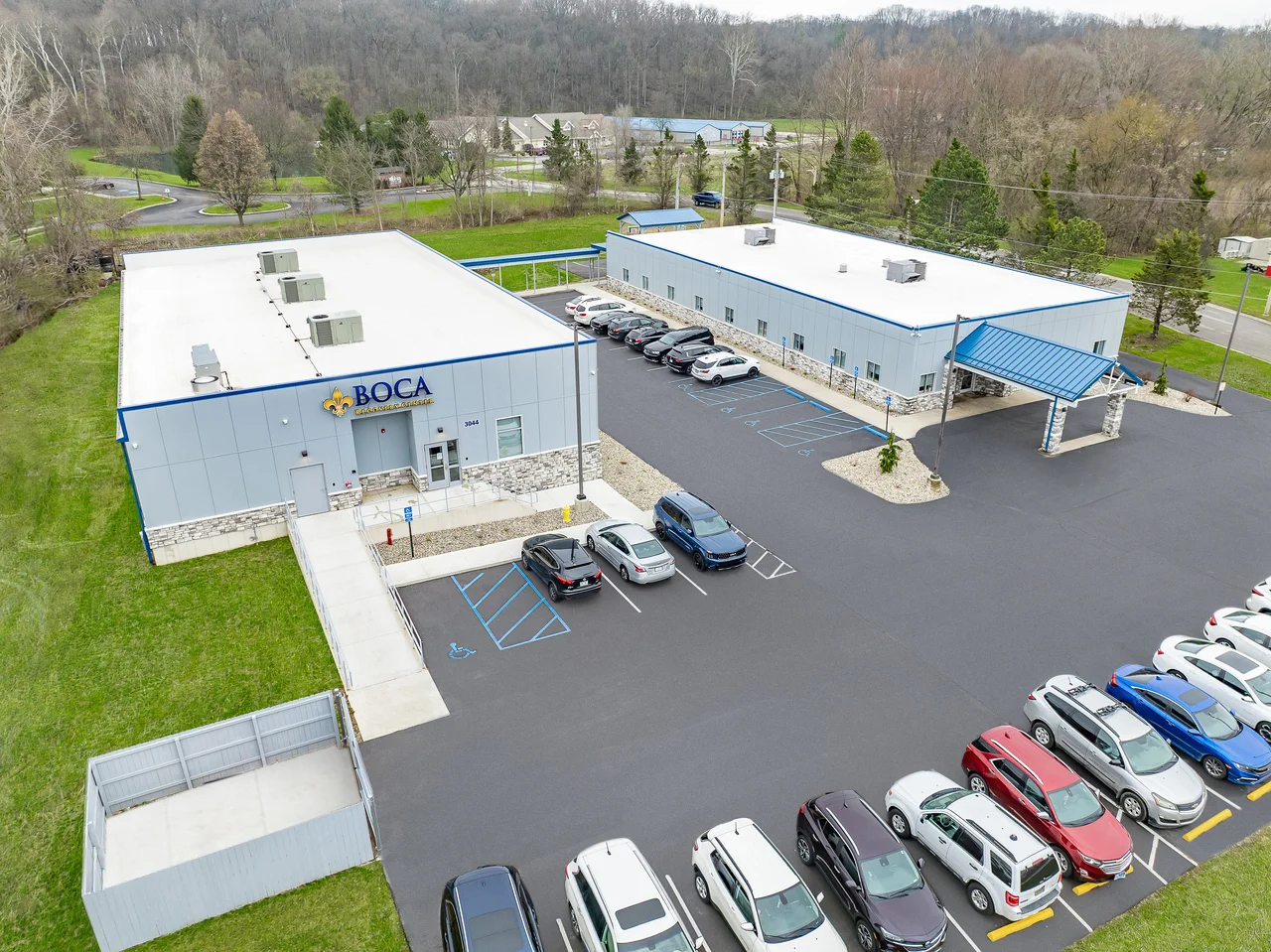Medication-assisted treatment (MAT) is a form of evidence-based addiction treatment that involves the use of FDA-approved medications to treat addiction. No medication cures addiction—there is no cure for this chronic condition—but many can be used to manage addiction long-term.
Medications like buprenorphine, methadone, and naltrexone treat opioid use disorder (OUD), while medications like acamprosate, naltrexone, and disulfiram treat alcohol use disorder (AUD).[1] The medications either manage withdrawal symptoms and cravings, decreasing the likelihood of substance abuse, or they block the effects of substances of abuse.
MAT also involves therapy to address underlying causes of substance abuse.
Many of our clients receive some level of MAT as part of their comprehensive plan, especially those entering our Indiana detox center, where stabilization begins before ongoing therapy.
The Role of Medication-Assisted Treatment in Addiction Recovery
MAT utilizes FDA-approved medications in combination with psychotherapy and counseling as part of a holistic addiction treatment approach. Medications supplement the benefits of talk treatments and make it easier for a client to stop abusing opioids or alcohol. As the medication lessens the likelihood of relapse, this promotes long-term recovery.[1]
Many medications can be used to treat both OUD and AUD. We discuss these medications in more depth in the next few sections.
How Effective Is Medication-Assisted Treatment?
Medication doesn’t fully treat addiction on its own. With MAT, it is used alongside therapy.
However, MAT is a proven concept when it comes to treating both OUD and AUD. While there is some variance in the data depending on the source, the medications currently approved by the FDA are shown to have an overall positive impact on treatment.
For OUD, MAT has been shown to dramatically improve long-term sobriety rates. It has been shown to reduce the rate of mortality by approximately 50% among people with OUD in treatment.[2]
A study in the American Journal of Psychiatry confirmed that MAT for AUD was linked to significant improvements in clinical outcomes after one year.[4] Studies widely conclude that MAT is beneficial for the treatment of both OUD and AUD, resulting in better long-term outcomes for participants.[5]
MAT & the Opioid Epidemic
The ongoing opioid abuse and overdose epidemic in the U.S. has been a persistent problem for decades. Overall, MAT has been largely underutilized when it comes to combating this epidemic.[6]
The epidemic has statistically worsened over the decades, primarily due to surges of new, more potent opioids entering the market. The recent influx of synthetic opioids like fentanyl has been a major problem.[7] Because of these surges, it can be hard to see how positive changes in combating the crisis have made an impact.
The emergence of telehealth and a growing acceptance of the utility of MAT has helped save lives during this epidemic, but the opioid crisis continues to be an ongoing problem that the U.S. has yet to truly and fully face.[8] At least on the individual level, seeking out telehealth treatments when in-person treatment isn’t available or desirable can help more people get treated. Using treatment paths that involve medication can help more people control their opioid cravings and stay sober.
Medications for Opioid Use Disorder
The nature of addictive drugs means that the medications used to treat addiction need to be customized based on the properties of the addictive substance in question. Put another way, the drugs that can treat OUD aren’t typically the same as those that can treat AUD. Opioids and alcohol are addictive for different reasons, although there is some overlap.
Below is a table comparing some of the medications approved by the FDA to treat OUD, followed by a more detailed explanation of each medication:[9-14]
| FDA Approval Date | Drug Class | Administration Method | Availability | Misuse Potential | Evidence Based? | |
| Buprenorphine | 2002 | Partial opioid agonist-antagonist | Oral or injection | Somewhat limited | Moderate abuse potential | Yes |
| Naltrexone | 1984 | Opioid antagonist | Oral or injection | Common | No abuse potential | Yes |
| Naloxone | 2015 | Opioid antagonist | Nasal spray or injection | Common | No abuse potential | Yes |
| Methadone | 1972 | Long-acting full opioid agonist | Drinkable liquid or injection | Limited | Moderate abuse potential | Yes (Highly) |
| Sublocade | 2002 | Partial opioid agonist- antagonist | Injection | Somewhat limited | Moderate abuse potential | Yes |
| Suboxone | 2002 | Partial opioid agonist- antagonist+opioid antagonist | Oral | Somewhat limited | Low abuse potential | Yes (Highly) |
| Subutex | 2002 | Partial opioid agonist- antagonist | Oral | Somewhat limited | Moderate abuse potential | Yes |
| Vivitrol | 2006 | Opioid antagonist | Injection | Common | No abuse potential | Yes |
Buprenorphine
Buprenorphine is a partial opioid agonist-antagonist. It binds imperfectly to opioid receptors in the brain and other parts of the body, blocking those receptors without producing the intense effect typical of opioid full agonists (the types of opioids more typically abused). It can be used to reduce opioid cravings and prevent opioid withdrawal in opioid-dependent individuals while still having a fairly low level of abuse potential.[15]
Naloxone
Naloxone is an opioid antagonist that can reverse the effects of opioids already in a person’s system. It can be life-saving for people who struggle with opioid abuse, as it can reverse a deadly opioid overdose and allow an individual to breathe.[16]
Importantly, it doesn’t treat OUD. In fact, when used, it will typically cause a person to go into opioid withdrawal if they regularly misuse opioids.
Naloxone comes on its own as a nasal spray and as an injectable medication. As described later, it can also be combined with other medications to reduce their abuse potential, such as Suboxone.
Naltrexone
Naltrexone is an opioid antagonist, blocking the effects of opioids and preventing opioid intoxication.[9] This medication can be taken preemptively by people seeking to quit opioid misuse, causing opioids to produce a much weaker effect in a user while naltrexone is in their system.
This sharply reduces the potential for opioid abuse. The drugs produce a weak, less rewarding effect that makes their abuse less tempting.
Naltrexone is available as an oral tablet or injection.
Suboxone
Suboxone is an OUD treatment medication that combines buprenorphine and naloxone. In most respects, it works as buprenorphine was described earlier. However, the introduction of naloxone reduces the abuse potential of the medication.[17]
If Suboxone isn’t taken as intended, such as if the tablets are crushed into a powder and injected in an attempt to cause a more intense effect, the naloxone will activate. This reverses the effects of all opioids in the user’s system, including the buprenorphine in the medication. This throws the user into sudden withdrawal, which can be very uncomfortable.
Suboxone is essentially a gold standard medication when it comes to MAT for OUD.[17] The combination of buprenorphine and naloxone allows the drug to reduce opioid cravings, and reduce or eliminate withdrawal symptoms, all without significant abuse potential.
Sublocade
Sublocade is a brand-name buprenorphine medication. It is specifically an extended-release injection, designed so a user only has to get a shot roughly once a month.[18] Some people like the freedom that Sublocade provides, as they don’t have to remember to use a medication like Suboxone daily.
Subutex
Subutex is a brand-name oral buprenorphine medication. This drug was discontinued in the U.S. in 2011.[19]
A 2008 study demonstrated that Subutex was already largely replaced by Suboxone for most users. Suboxone was more appealing due to its lower abuse potential, findings that have been more or less replicated in multiple other studies as well.[20]
Vivitrol
Vivitrol is a brand-name extended-release naltrexone injectable medication. The use of Vivitrol for opioid use disorder or comparable medications is relatively standard, at least in patients who won’t be taking buprenorphine or methadone.
Its advantages are identical to those described in the subsection on naltrexone. Its active ingredient is the same drug.[5]
Methadone
Methadone is a long-acting opioid full agonist, and it can serve a similar purpose to buprenorphine. While it may seem odd that an opioid full agonist (the same class that opioids of abuse typically reside in) is used to treat opioid addiction, evidence has shown that when taken as prescribed, methadone can help people avoid opioid abuse.[10]
Methadone is highly controlled. In most cases, a person must visit specialized methadone clinics to get access to methadone. They take their dose at the clinic and must return to the clinic daily to receive additional doses. This level of regulation is somewhat controversial, as experts often argue it’s an overcorrection. While this step does prevent abuse to a degree, it also makes methadone treatment much less accessible for many people.
Medications for Alcohol Use Disorder
AUD, like OUD, can be treated in part with medications. There has been perhaps less research in this area than with OUD, but several FDA-approved options exist that can treat AUD. This chart breaks down the primary medications used to treat AUD:[9,21-23]
| FDA Approval Date | Drug Class | Administration Method | Availability | Misuse Potential | Evidence Based? | |
| Disulfiram | 1951 | Alcohol-sensitizing agent | Oral | Common | No abuse potential | Safe but mixed |
| Acamprosate | 2004 | N-methyl-D-aspartate receptor Modulator | Oral | Common | No abuse potential | Yes |
| Naltrexone | 1994 | Opioid antagonist | Injection | Common | No abuse potential | Yes |
Disulfiram (Antabuse)
Disulfiram, often sold under the brand name Antabuse, is an alcohol-sensitizing agent.[24] When taken, it causes a person to experience unpleasant side effects (like nausea, headache, vomiting, chest pains, and difficulty breathing) when they consume even small amounts of alcohol.
The medication is meant to dissuade a person from drinking, and if a person is motivated to take this medication, it can accomplish this goal. However, it’s often viewed as a punitive approach to treatment. Many people who struggle with AUD may eventually choose to stop taking it because of how bad it can make them feel in the event of a relapse.[11]
While disulfiram’s effects are unpleasant if alcohol is consumed, it won’t typically cause a life-threatening reaction. However, it still should not be taken within 12 hours of drinking.[11]
Acamprosate (Campral)
Acamprosate, also known by the brand name Campral, is a medication that can help a person cut down on drinking. While its mechanism isn’t fully understood, it has been shown in studies to significantly reduce instances of relapse to alcohol use and promote long-term recovery.[22]
It also has the advantage of not being metabolized by the liver or impacted by alcohol use. This means that people with conditions like hepatitis or liver disease can still take it without issue.
Naltrexone (Vivitrol)
Naltrexone, typically sold under the brand name Vivitrol, may seem like an odd medication to use in the treatment of AUD because it’s an opioid antagonist. However, the use of Vivitrol for AUD is evidence-based.[9]
Naltrexone has been shown to block the euphoric and intoxicating effects associated with alcohol use.[11] This enables a person to stay motivated and avoid using alcohol, remain in treatment, and better avoid relapse.
Overcoming the Stigma of Medication-Assisted Treatment
There is an unfortunately common belief that MAT is “trading one addiction for another” or even that it’s somehow an inherently less valid way to combat addiction compared to an approach that doesn’t use medication. This is a dangerous way of thinking.
The medications approved for use in MAT are evidence-based, meaning they’re shown to have a net positive effect when it comes to helping people who struggle with addiction. These medications save lives, and the data overwhelmingly supports that.[11,14,23]
While it’s true that these medications may be taken indefinitely, many don’t cause any level of dependence. Most aren’t addictive, and most don’t have effects that would warrant their abuse.
While medications like methadone and buprenorphine can cause dependence and some euphoria if misused, they’ve still been shown to help people not abuse opioids, especially when taken exactly as prescribed. Suboxone, which combines buprenorphine with naloxone, is an even more obvious case of a beneficial drug, as the naloxone in the drug makes it much harder to abuse.
Paying for Medication-Assisted Treatment
The cost of MAT can vary. You can typically expect treatment to cost upward of $115 per week, with some treatments, such as naltrexone treatments, potentially costing significantly more. Naltrexone specifically costs as much as $1,176 or more per month.[25]
Typically, medication-assisted treatment should be covered under most insurance plans. For coverage, treatments must be evidence-based, and you must be deemed by a medical professional to likely benefit from such treatments. Some people may also be able to find other types of financial assistance, such as taking out medical loans, to further help them pay for treatment.[25]
Here at Boca Recovery Center, we will verify your insurance plan to ensure you maximize your coverage. We help every client get the care they need, including helping them find any relevant financial assistance or scholarships that might be available to offset the costs of care. We understand the cost and time commitment of treatment can be burdensome, and we aim to make treatment as readily and easily available to as many people as possible.
Is Medication-Assisted Treatment Right for Me?
The experienced team at Boca Recovery Center will evaluate you when you decide to enter rehab. During your intake evaluation, we will diagnose your substance use disorder and the severity of your addiction. We will also assess you for any co-occurring mental health issues. Based on this assessment, we will recommend the most appropriate form of medication-assisted treatment for you (if you are found to be a suitable candidate for MAT).
MAT is usually prescribed to people who meet these criteria:
- Have been officially diagnosed with a substance use disorder
- Are motivated to comply with instructions and take the prescription medication as directed
- Do not have any medical conditions that could be worsened by MAT drugs
- Understand their options and are educated about the potential side effects of MAT
You are NOT a good candidate for medication-assisted drug rehab if you have the following:
- An addiction to a substance that cannot be treated with MAT
- A co-occurring addiction that may interfere with treatment
- A severe medical condition that could be complicated by MAT drugs
- Poor motivation to stop substance abuse
Medication-Assisted Treatment at Boca Recovery Center
At Boca Recovery Center, we help clients develop a holistic treatment plan that meets their addiction treatment needs. Many of our clients receive some level of MAT as part of their comprehensive treatment plan, including the use of FDA-approved medications for alcohol addiction and opioid addiction.
Our treatment plans are personalized to meet the individual needs of each person, and we adapt your plan as you progress in treatment. Reach out to us today to learn more about how our MAT offerings can form the basis of your recovery. When you’re ready for help, call our team or visit our Florida alcohol & drug rehab for compassionate guidance.
Frequently Asked Questions About MAT
Some frequently asked questions about MAT include the following:
MAT can vary in length. Some people benefit from medication indefinitely.[26] As long as medication continues to support your recovery, there is no reason to stop taking it. However, many people work with their doctor to eventually stop taking drugs like Suboxone or methadone. Your addiction treatment team can help you determine the right decision for you.
If you want to stop MAT, talk to your treatment team or doctor rather than suddenly stop on your own.
While any medication has the potential to cause negative side effects, the medications used for MAT are considered safe. Most of these FDA-approved drugs have low or no abuse potential and little risk of causing severe side effects.[27] Many of the medications don’t cause dependence (although some do). Talk to your doctor about what to expect when you take the medication.
Some medications approved for MAT are more tightly regulated than others. Buprenorphine and methadone medications have certain rules in place that can sometimes limit which professionals can prescribe or administer them, although most addiction treatment professionals either can do so or will be able to easily direct you to someone who can do so.[28] Other medications can be prescribed, distributed, or administered in ways that are more typical of other types of prescription drugs.
There are some supplemental medications—such as gabapentin, Wellbutrin, and ibogaine—that are sometimes used to help with addiction treatment, but it’s important to note that these medications aren’t approved for this purpose.[29-31] This doesn’t mean they can’t help, but the research on their benefits is incomplete or mixed.[32] Doctors must work with their patients to assess the unknowns and risks against the potential benefits of these less-tested treatments before prescribing them.
- Medications for substance use disorders. Substance Abuse and Mental Health Services Administration. Published February 1, 2024. Accessed March 14, 2024.
- Medications for opioid use disorder save lives. National Academies Press (US). Published March 30, 2019. Accessed March 14, 2024.
- Robertson AG, Easter MM, Lin H, Frisman LK, Swanson JW, Swartz MS. Medication-assisted treatment for alcohol-dependent adults with serious mental illness and criminal justice involvement: Effects on treatment utilization and outcomes. American Journal of Psychiatry. 2018;175(7):665-673.
- Heidbreder C, Fudala PJ, Greenwald MK. History of the discovery, development, and FDA-approval of buprenorphine medications for the treatment of opioid use disorder. Drug and Alcohol Dependence Reports. 2023;6:100133.
- An overview of medication-assisted treatment for opioid and alcohol use disorders. AJMC.
- Allen B, Nolan ML, Paone D. Underutilization of medications to treat opioid use disorder: What role does stigma play? Substance Abuse. 2019;40(4):1-7.
- Brent J, Weiss ST. The opioid crisis—Not just opioids anymore. JAMA Network Open. 2022;5(6):e2215432.
- Mahmoud H, Naal H, Whaibeh E, Smith A. Telehealth-based delivery of medication-assisted treatment for opioid use disorder: a Critical Review of Recent Developments. Current Psychiatry Reports. 2022;24(9):375-386.
- Naltrexone. StatPearls. Published January 2024. Accessed March 14, 2024.
- Federal regulation of methadone treatment. National Academies Press (US). Published 1995. Accessed March 14, 2024
- Medications, counseling, and related conditions. Substance Abuse and Mental Health Services Administration. Published January 5, 2024. Accessed March 14, 2024.
- Drug approval package. U.S. Food and Drug Administration. Published April 13, 2006. Accessed March 14, 2024.
- Narcan FDA approval history. Drugs.com. Accessed March 14, 2024.
- Medications for opioid use disorder: For healthcare and addiction professionals, policymakers, patients, and families: Updated 2021. Substance Abuse and Mental Health Services Administration. Published 2018. Accessed March 14, 2024.
- Shulman M, Wai JM, Nunes EV. Buprenorphine treatment for opioid use disorder: An overview. CNS Drugs. 2019;33(6):567-580.
- Jordan MR, Morrisonponce D. Naloxone. StatPearls. Published 2019. Accessed March 14, 2024.
- Velander JR. Suboxone: Rationale, science, misconceptions. The Ochsner journal. 2018;18(1):23-29.
- Lorman, William J. Sublocade: The once-monthly buprenorphine injection. Journal of Addictions Nursing. 2018;29(2):139-140.
- Why was Subutex discontinued? Drugs.com. Accessed March 14, 2024.
- Simojoki K, Vorma H, Alho H. A retrospective evaluation of patients switched from buprenorphine (Subutex) to the buprenorphine/naloxone combination (suboxone). Substance Abuse Treatment, Prevention, and Policy. 2008;3(1):16.
- Incorporating alcohol pharmacotherapies into medical practice. Substance Abuse and Mental Health Services Administration. Published 2009. Accessed March 14, 2024.
- Witkiewitz K, Saville, Hamreus. Acamprosate for treatment of alcohol dependence: mechanisms, efficacy, and clinical utility. Therapeutics and Clinical Risk Management. 2012;8:45.
- A step forward in the treatment of opioid and alcohol dependence with Dr. Lilun Murphy and Dr. Martasokolowska. U.S. Food and Drug Administration. Published March 5, 2024. Accessed March 14, 2024.
- Stokes M, Abdijadid S. Disulfiram. StatPearls. Published October 24, 2022. Accessed March 15, 2024.
- How much does opioid treatment cost? National Institute on Drug Abuse. Published April 13, 2021. Accessed March 15, 2024.
- Mancher M, Leshner AI. The effectiveness of medication-based treatment for opioid use disorder. National Academies Press (US); 2019.
- Goldfine C, Chapman B, Taylor M, et al. Experiences with medications for addiction treatment among emergency department patients with opioid use disorder. Western Journal of Emergency Medicine. 2023;24(2):236-242.
- Federal guidelines for opioid treatment programs. Substance Abuse and Mental Health Services Administration. Published January 2015. Accessed March 15, 2024.
- Buttram ME, Kurtz SP, Ellis MS, Cicero TJ. Gabapentin prescribed during substance abuse treatment: The perspective of treatment providers. Journal of Substance Abuse Treatment. 2019;105:1-4.
- Marton S, González B, Rodríguez-Bottero S, et al. Ibogaine administration modifies GDNF and BDNF expression in brain regions involved in mesocorticolimbic and nigral dopaminergic circuits. Frontiers in Pharmacology. 2019;10:193.
- Magyar, H. Bupropion: Off-label treatment for cocaine and methamphetamine addiction. Current Psychiatry. Published July 2010. Accessed March 15, 2024.
- Paino M, Aletraris L, Roman PM. The use of off-label medications in substance abuse treatment programs. Substance Abuse. Published July 30, 2019:1-7.















